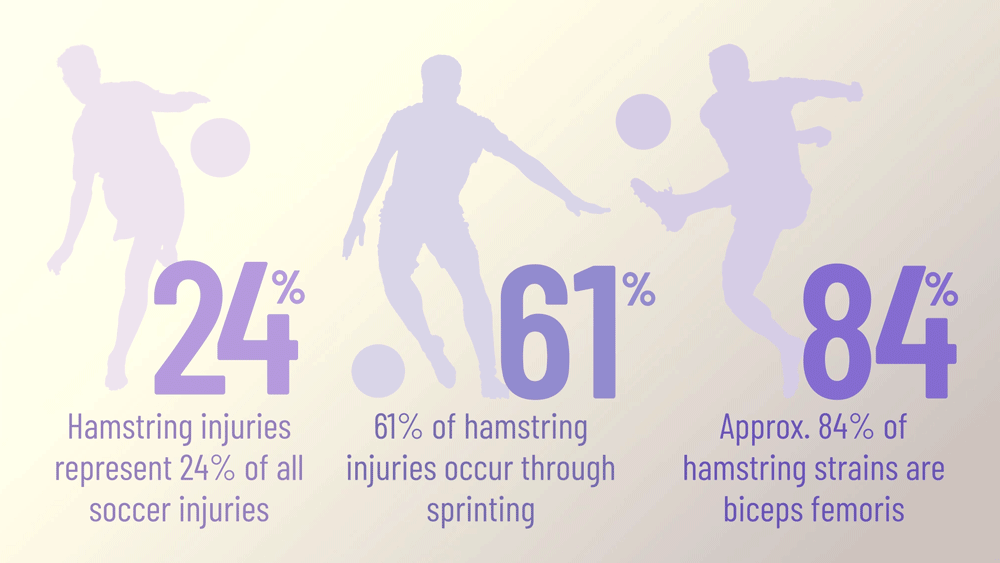Breaking Down The Landscape In The Battle Against Hamstring Injuries
Hamstring injuries represent 24% of all soccer injuries
In addition, hamstrings are responsible for 20% of all injury related player absence days. Both of these figures have doubled since UEFA launched their injury research in 2001/02.
A playing squad will average 8 hamstring strains per season
Every season, 20% of players miss training or match play due to hamstring injury. The average lay off for a player following a hamstring injury is 13 days.
Hamstring injuries occur mainly through sprint mechanisms
By far the most common mechanism of hamstring injury is sprinting, which is responsible for 61% of injuries. 12% of injuries occur due to overuse/gradual onset, and 5% through stretching. ECIS data classifies 22% of injuries as ‘other’, meaning their exact mechanism cannot be determined.
Approximately 84% of hamstring strains occur in the biceps femoris
To effectively reduce hamstring strains, it is clear that identifying the reasons why the biceps femoris fails so frequently should be prioritised. Of the remainder, approximately 11% of hamstring strains occur in the semimembranosus & 5% occur in the semitendonosus (1)
Most hamstring injuries occur in games
Incidence of hamstring injury is 10x higher during match play than training, a fact which raises two points:
- Firstly, are players being protected from training related injuries by conservative management of their training load, leading to under-training and therefore failure to develop the physical capacity needed to protect against injury in matches?
- Or, secondly, are players being exposed to an excessive number of matches in a shortened time period, and therefore sustaining injury through under-recovery and accumulated fatigue?
The majority of injuries occur towards the end of each half
Almost 50% of hamstring injuries occur during the last 15 minutes of the first and second half, indicating that tolerance to fatigue plays a role in making the hamstring more susceptible to injury.
Risk of re-injury is high
Athletes with a history of just one previous hamstring injury are 2.7 times more likely to sustain an injury than players with no hamstring injury record (4) – and this risk increases with any subsequent injuries.
ECIS data revealed that 18% of all hamstring injuries are recurrences, the vast majority of which are classified as ‘early recurrences’, meaning they happen within two months of the player returning to play. This is a matter of concern, because re-injuries have been shown to cause significantly longer player absences than initial injuries. Two important questions are raised by this finding:
- Firstly, are re-injuries being contributed to by ineffective injury management, inadequate rehabilitation or poor-quality return to play programmes for these injured players?
- Or, secondly, has the original injury caused a maladaptation or a change in muscle function which will affect the long-term health of the player, meaning that they will have to be managed in a different way in their future training programmes? This reinforces the importance of taking appropriate steps to stop initial injuries from occurring.
Why is breaking down the injury landscape in this way important?
An overview of hamstring injuries such as this not only allows us to establish the scale of the problem, it also provides practitioners with a clearer view of when, where, and how they happen. Understanding the conditions under which hamstring injuries commonly occur, and identifying the specific mechanisms of injury, should mean that training interventions can be put into place which reduce the potential of hamstring injuries from occurring. But are they?
What are teams doing to mitigate hamstring injuries?
Extensive research has proposed various interventions designed to lower hamstring injuries, and this has led teams to adopt systematic, criteria-based prevention programmes. Despite this, hamstring injuries are not decreasing – in fact, the evidence is pointing in the opposite direction, suggesting that current preventative measures are not effective.
Part of the problem is that injuries can be influenced by a number of different factors, including training load, the quality of S&C programmes, the implementation of appropriate recovery strategies, the quality of the players nutrition, and the lifestyle choices which are made by the player themselves. Everybody who plays an active role in the preparation and development of a soccer players has a responsibility to reduce injuries, including the medical professionals, the sports science department, the coaching staff, and, crucially, the player themselves. For that reason, it’s vital that a multi-faceted, integrated approach be adopted, in order to minimise the incidence of injury as effectively as possible.
Why are hamstring injury prevention programmes not reducing hamstring injuries?
The reality in sports teams is that all too often these stakeholders don’t collaborate as closely as they could. Decisions are made in isolation because the information and data relevant to injury prevention doesn’t flow quickly enough between medical staff, S&C practitioners, coaches and players. One of the most significant recommendations from the ECIS author is that ‘clubs with good internal communication showed fewer injuries and greater player availability’, and that ‘teams with a low communication quality had a 50% higher injury burden compared to teams with a moderate-high communication quality’ (3). Bridging data and communication gaps is key for injury prevention.
Where Apollo makes a real difference
ApolloV2’s athlete performance software unlocks data silos allowing coaches, trainers, doctors and players to become masters of data-driven performance with real-time data visualization and collaboration tools. Our software is integrated with over 50 performance focused technologies used by college and professional athletes. With ApolloV2, teams have the information they need to minimize hamstring injuries and optimize player availability.
To learn more about using ApolloV2 for injury prevention email info@apollov2.com
Written by Adrian Lamb, ApolloV2 Sports Scientist


Recent Comments